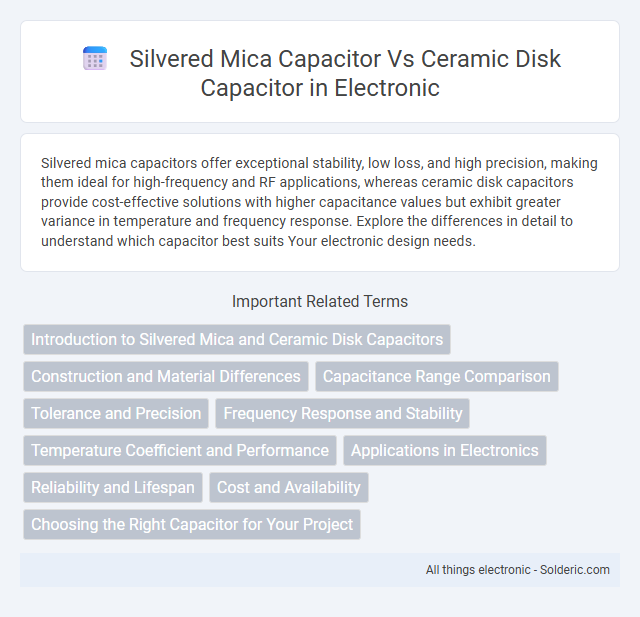Silvered mica capacitors offer exceptional stability, low loss, and high precision, making them ideal for high-frequency and RF applications, whereas ceramic disk capacitors provide cost-effective solutions with higher capacitance values but exhibit greater variance in temperature and frequency response. Explore the differences in detail to understand which capacitor best suits Your electronic design needs.
Comparison Table
| Feature | Silvered Mica Capacitor | Ceramic Disk Capacitor |
|---|---|---|
| Dielectric Material | Mica with a silver coating | Ceramic |
| Capacitance Range | 1 pF to 100 pF | 1 pF to several uF |
| Tolerance | +-1% to +-5% | +-5% to +-20% |
| Temperature Stability | Excellent | Moderate to low |
| Frequency Characteristics | High frequency, low loss | Lower frequency, higher losses |
| Voltage Rating | High (up to several kV) | Low to medium (up to a few hundred volts) |
| Applications | RF circuits, oscillators, filters | General purpose, bypass, coupling |
| Cost | Higher | Lower |
| Physical Size | Small | Varies, generally compact |
Introduction to Silvered Mica and Ceramic Disk Capacitors
Silvered mica capacitors are known for their high precision, low loss, and excellent temperature stability, making them ideal for high-frequency applications and RF circuits. Ceramic disk capacitors offer a cost-effective solution with a wide range of capacitance values and good reliability, commonly used in general-purpose electronic circuits. Your choice depends on the specific requirements for frequency stability, tolerance, and environmental conditions in your project.
Construction and Material Differences
Silvered mica capacitors use thin sheets of mica coated with a layer of silver to form electrodes, providing high stability and precision in capacitance values. Ceramic disk capacitors consist of ceramic dielectric materials with metalized electrodes on both sides, offering compact size and higher capacitance ranges. The distinct materials and construction methods result in significant differences in temperature stability, tolerance, and frequency response between the two types.
Capacitance Range Comparison
Silvered mica capacitors typically offer capacitance values ranging from 1 pF to around 1000 pF, making them ideal for precision and high-frequency applications. Ceramic disk capacitors cover a much broader capacitance range, from a few picofarads to several microfarads, suitable for general-purpose use and bulk energy storage. The narrower capacitance range of silvered mica capacitors results in higher stability and tolerance compared to the wider but less precise values of ceramic disk capacitors.
Tolerance and Precision
Silvered mica capacitors offer superior tolerance and precision, typically within +-1% or better, making them ideal for high-frequency and RF applications where stability is critical. Ceramic disk capacitors generally have wider tolerance ranges, often between +-5% to +-20%, resulting in less precise capacitance values and greater variability over temperature. Your choice should depend on the required accuracy; for precision circuits, silvered mica capacitors provide more reliable performance.
Frequency Response and Stability
Silvered mica capacitors offer superior frequency response and exceptional stability, making them ideal for high-frequency applications and precision circuits. Ceramic disk capacitors tend to exhibit more variation in capacitance with temperature and frequency, leading to less stable performance over time. Your choice should favor silvered mica when consistent, low-loss behavior is critical.
Temperature Coefficient and Performance
Silvered mica capacitors offer superior temperature stability with a low temperature coefficient typically around +-100 ppm/degC, ensuring consistent capacitance across wide temperature ranges. Ceramic disk capacitors exhibit higher temperature coefficients, often ranging from +-30 ppm/degC to +-3300 ppm/degC depending on the ceramic class, which can lead to capacitance variation under thermal stress. Your choice in applications demanding precise and stable performance under varying temperatures often favors silvered mica capacitors.
Applications in Electronics
Silvered mica capacitors excel in high-frequency and precision applications like RF circuits, oscillators, and filters due to their superior stability and low dielectric loss. Ceramic disk capacitors are widely used for general-purpose applications such as decoupling, bypass, and coupling in consumer electronics and power supplies, thanks to their cost-effectiveness and compact size. Your choice depends on the need for precision and stability or affordability and versatility in electronic circuit design.
Reliability and Lifespan
Silvered mica capacitors exhibit superior reliability and longer lifespan due to their stable dielectric material, which offers low losses and exceptional thermal stability under harsh conditions. Ceramic disk capacitors, while cost-effective and compact, generally have shorter lifespans and are more susceptible to aging and capacitance loss over time, especially in high voltage or high-temperature environments. The inherent stability of silvered mica capacitors makes them ideal for precision circuits requiring long-term performance and minimal degradation.
Cost and Availability
Silvered mica capacitors generally have a higher cost due to their precise manufacturing process and superior stability, making them less readily available in standard electronics stores compared to ceramic disk capacitors. Ceramic disk capacitors are widely produced, cost-effective, and commonly stocked, offering broad availability for various applications. When choosing components for your project, ceramic disk capacitors provide a budget-friendly and easily accessible option, while silvered mica capacitors deliver premium performance at a premium price.
Choosing the Right Capacitor for Your Project
Silvered mica capacitors offer superior stability, low loss, and precise capacitance, making them ideal for high-frequency RF circuits and precision timing applications. Ceramic disk capacitors are cost-effective, provide high capacitance per volume, and work well in general-purpose filtering and decoupling tasks. Selecting the right capacitor depends on circuit requirements like frequency stability, tolerance, dielectric loss, and budget constraints.
silvered mica capacitor vs ceramic disk capacitor Infographic

 solderic.com
solderic.com